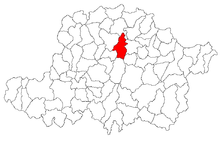Ineu
|
Ineu Borosjenő Jenopolje / Јенопоље |
||||
|
||||
| Basic data | ||||
|---|---|---|---|---|
| State : |
|
|||
| Historical region : | Screeching area | |||
| Circle : | Arad | |||
| Coordinates : | 46 ° 26 ' N , 21 ° 50' E | |||
| Time zone : | EET ( UTC +2) | |||
| Height : | 111 m | |||
| Area : | 116.62 km² | |||
| Residents : | 9,260 (October 20, 2011) | |||
| Population density : | 79 inhabitants per km² | |||
| Postal code : | 315300 | |||
| Telephone code : | (+40) 02 57 | |||
| License plate : | AR | |||
| Structure and administration (as of 2016) | ||||
| Community type : | city | |||
| Structure : | 1 District / cadastral municipality: Mocrea | |||
| Mayor : | Călin-Ilie Abrudan ( PNL ) | |||
| Postal address : | St. Republicii, no. 5 loc. Ineu, jud. Arad, RO-315 300 |
|||
| Website : | ||||
| Others | ||||
| City Festival : | August | |||
Ineu (obsolete Boroșineu or Ienopolea ; German obsolete Jenopol , Hungarian Borosjenő , Serbo-Croatian Jenopolje / Јенопоље ) is a town in Arad County , in the Kreischgebiet , in western Romania .
Geographical location
Ineu is located in western Romania, on the western edge of the Apuseni Mountains , on both sides of the Crișul Alb ( White Screech ) river. The district capital Arad is located about 50 km southwest.
history
The history of Ineu is closely linked to the castle, which was first mentioned in 1295. At the time of the Kingdom of Hungary, the castle was the center of a great feudal rule, which at times included 51 villages. After the Battle of Mohács , the place became part of the Principality of Transylvania in 1541 . In 1566 the Turks conquered Ineu. In 1595 Transylvania and in 1599 the Wallachian prince Mihai Viteazul briefly took control of the place before it became part of Transylvania again. By the Treaty of Karlowitz Ineu came to Austria-Hungary in 1699 . After Ineu was no longer near the border due to the Peace of Passarowitz (1718), it lost its importance; the castle fell into disrepair. In the 19th century, Ineu developed into a local economic center. In 1849 the place was occupied by Russian troops during the Hungarian Revolution . In 1870 the castle was restored in neoclassical style. In 1877 Ineu was connected to the railway network. After the First World War it came to Romania.
In 1967 Ineu was granted city status.
The most important branches of industry are agriculture, livestock and fish farming, textile and electrical industries.
population
In 1850, 5834 people lived in the area of today's city, of which 3374 Romanians , 1550 Hungarians , 262 Germans and 229 Slovaks . In 1992 the population peaked at 10,915 and has been falling since then. In the 2002 census, 10,207 inhabitants were registered in Ineu, including 8,740 Romanians, 860 Hungarians, 517 Roma , 47 Germans and 29 Slovaks. 9,312 people lived in the actual city, Ineu in the narrower sense, 895 in the incorporated town of Mocrea . In 2011, 9260 people were registered in the area of the city. 7715 of them were Romanians, 593 Magyars, 528 were Roma, 30 Germans, seven each declared themselves to be Slovaks and Jews, four Italians, three Ukrainians and the rest did not provide any information about their ethnicity.
traffic
Ineu has a train station on the line from Arad to Brad . In the city there is also a branch line to Cermei . Local trains run to these places several times a day. Bus traffic is also important (regular connections to Oradea ).
Recreational sports
In order to reactivate the former Mocrea airfield, the "Aero-Club Ineu" was founded. The association has set itself the goal of expanding air sports in the region around Ineu. The establishment of a flight school is also planned to provide appropriate training for everyone interested in flying.
Attractions
- The castle, built in the 17th century, and parts of the city center are listed.
- Solymosy Castle in Mocrea, built in the 19th century and now a psychiatric clinic, is a listed building.
- Dealul Viilor Recreation Area
Personalities
- Đorđe Branković (1645–1711), Serbian-Transylvanian count
Web links
Individual evidence
- ↑ 2011 census in Romania ( MS Excel ; 1.3 MB)
- ^ Mathias Bernath, Felix von Schröder (Ed.): Biographical Lexicon for the History of Southeast Europe. Munich, Oldenbourg 1979. ISBN 3-486-48991-7
- ^ Dictionary of localities from Transylvania
- ↑ Website of the city, accessed on February 2, 2009 ( Memento of the original from January 14, 2006 in the Internet Archive ) Info: The archive link was inserted automatically and has not yet been checked. Please check the original and archive link according to the instructions and then remove this notice.
- ↑ Enciclopedia România, accessed February 2, 2009
- ↑ 2002 census, accessed on January 2, 2008 (PDF; 766 kB)
- ↑ aeroclub-ineu.home.ro ( Memento of the original from March 4, 2016 in the Internet Archive ) Info: The archive link was inserted automatically and has not yet been checked. Please check the original and archive link according to the instructions and then remove this notice. , Aeronautical Club Ineu
- ↑ a b List of historical monuments of the Romanian Ministry of Culture, updated 2010 (PDF; 7.10 MB)



